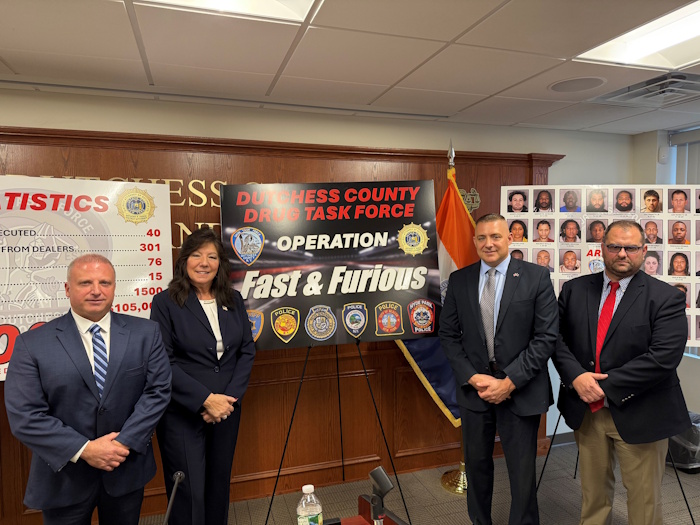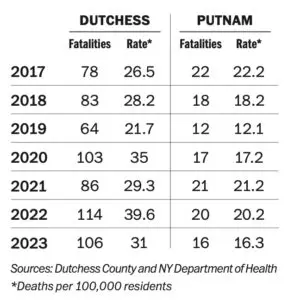Officials credit policing, public health initiatives
Overdose deaths have plummeted this year in Dutchess, igniting a celebration in a county that until recently had one of the state’s highest rates.
Dutchess has recorded 38 deaths in 2024 through Sept. 30, or 58 percent fewer than the same period in 2023 and 64 percent fewer than 2022, according to Jean-Marie Niebuhr, the county commissioner of mental health. Dutchess had 91 deaths during the first nine months of 2023 and 106 for the year.
On Dec. 11, District Attorney Anthony Parisi and Sheriff Kirk Imperati announced the completion of Operation Fast and Furious, an 18-month initiative built on “hot spot” policing, shorter investigations, expedited warrants and other strategies to identify and prosecute dealers, including in Beacon.

Niebuhr said the reduction is also a product of public health initiatives, including the expanded availability of buprenorphine and other medications used to treat addiction, the training of people in the use of the overdose-reversal medication naloxone and the distribution of preventative tools like strips that test for the presence of fentanyl.
Some of those initiatives have benefited from $4.5 million sent to Dutchess County from the state’s settlement with pharmaceutical companies accused of pushing opioids on patients who became addicted. More Dutchess residents also entered treatment in 2023, according to state data.
“It’s so awful to see someone die an untimely and preventable death,” said Niebuhr. “And it’s so heartwarming to see that those numbers are finally starting to come down.”
Dutchess ended 2022 with 114 overdose deaths and the fourth-highest rate of deaths (39.6 per 100,000) among counties outside New York City, trailing Sullivan (61.5), Chautauqua (44.7) and Monroe (42.3). With 64 deaths in the first half of 2023, the county was on pace to exceed its 2022 total.
But Dutchess finished with eight fewer fatalities in 2023, when overdose deaths fell by 3 percent nationwide, according to the federal Centers for Disease Control and Prevention. Deaths also fell in New York state and Putnam County.

The downward trend in Dutchess accelerated this year as the task force and DA’s office continued a seven-prong strategy implemented in April 2023. The plan, they say, has yielded 76 drug and gun arrests, 301 undercover purchases, the seizure of 15 illegal handguns and $105,000 in cash and 1,500 pieces of evidence.
In addition to identifying spots where dealers congregate and immediately launching investigations, the task force used “cutting-edge investigative techniques” to collect evidence, said Parisi and Imperati at the news conference. They shortened into months investigations that once took years by assigning all task force personnel to single cases. “We are not just enforcing the law but working together to take those who peddle poison off our streets,” said Parisi.
In addition to prosecutions, Dutchess’ expansion of the availability of medications used to treat addiction has been critical in reducing deaths, said Niebuhr.
Anyone being held in the Dutchess County jail can be immediately prescribed addiction medications, which reduce withdrawal symptoms and cravings. Recent data shows nearly half of inmates are taking medications for opioid abuse, said Niebuhr.
“It’s a ripe opportunity to engage with people because they’re in a setting where they’re experiencing these terrible withdrawal symptoms and someone is saying to them, ‘I have something that can help you,’” she said.
Before inmates are released, a recovery coach helps them find a program in their community. A county study found that no inmate who agreed to take medication has died of an overdose after being released, a result Niebuhr described as “staggering.”
In addition, the Lexington Center for Recovery began dispensing methadone at its clinic in Dover Plains, a boon to people who faced the challenge of traveling to Poughkeepsie every day for their dose, said Niebuhr. Another facility, MidHudson Regional Hospital in Poughkeepsie, received a grant to administer buprenorphine to people transported to its emergency room, she said.
Dutchess also has a multi-agency team that, two years ago, began reviewing overdose fatalities to identify gaps in services. Those reviews led to the creation of “leave-behind kits” containing naloxone, harm-reduction supplies such as fentanyl test strips and information on services.
Paramedics and other first responders have been trained in distributing the kits to survivors who refuse long-term treatment. Supplies such as naloxone can also be accessed for free from a “vending” machine placed in the City of Poughkeepsie, and Dutchess deploys outreach teams to areas where drug users congregate.
“The data is clear that harm reduction works to help keep people alive,” said Niebuhr.

